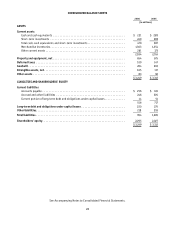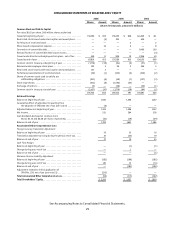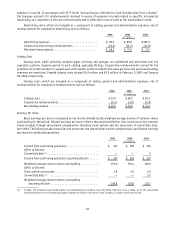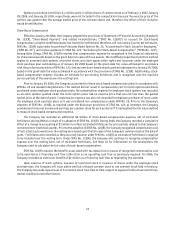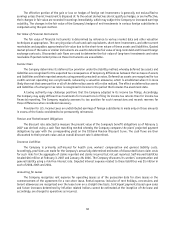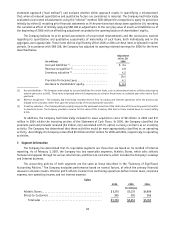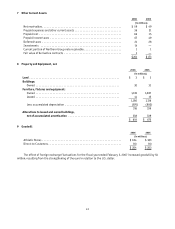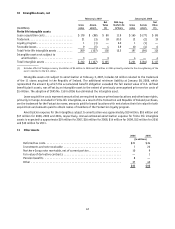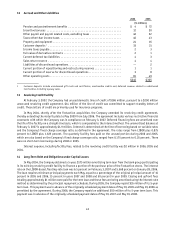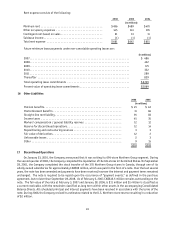Foot Locker 2006 Annual Report Download - page 51
Download and view the complete annual report
Please find page 51 of the 2006 Foot Locker annual report below. You can navigate through the pages in the report by either clicking on the pages listed below, or by using the keyword search tool below to find specific information within the annual report.35
Property and Equipment
Property and equipment are recorded at cost, less accumulated depreciation and amortization. Significant
additions and improvements to property and equipment are capitalized. Maintenance and repairs are charged to
current operations as incurred. Major renewals or replacements that substantially extend the useful life of an asset are
capitalized and depreciated. Owned property and equipment is depreciated on a straight-line basis over the estimated
useful lives of the assets: maximum of 50 years for buildings and 3 to 10 years for furniture, fixtures and equipment.
Property and equipment under capital leases and improvements to leased premises are generally amortized on a
straight-line basis over the shorter of the estimated useful life of the asset or the remaining lease term. Capitalized
software reflects certain costs related to software developed for internal use that are capitalized and amortized.
After substantial completion of the project, the costs are amortized on a straight-line basis over a 2 to 7 year period.
Capitalized software, net of accumulated amortization, is included in property and equipment and was $29 million at
February 3, 2007 and $39 million at January 28, 2006.
Recoverability of Long-Lived Assets
In accordance with SFAS No. 144, “Accounting for the Impairment or Disposal of Long-Lived Assets” (“SFAS
No. 144”), an impairment loss is recognized whenever events or changes in circumstances indicate that the carrying
amounts of long-lived tangible and intangible assets with finite lives may not be recoverable. Assets are grouped and
evaluated at the lowest level for which there are identifiable cash flows that are largely independent of the cash flows
of other groups of assets. The Company has identified this lowest level to be individual stores. The Company considers
historical performance and future estimated results in its evaluation of potential impairment and then compares the
carrying amount of the asset with the estimated future cash flows expected to result from the use of the asset. If the
carrying amount of the asset exceeds estimated expected undiscounted future cash flows, the Company measures the
amount of the impairment by comparing the carrying amount of the asset with its estimated fair value. The estimation
of fair value is generally measured by discounting expected future cash flows at the Company’s weighted-average cost
of capital. The Company estimates fair value based on the best information available using estimates, judgments and
projections as considered necessary.
During 2006, the Company recorded an impairment charge of $17 million ($12 million after-tax) to write-down
long-lived assets such as store fixtures and leasehold improvements in 69 stores in the European operations to their
estimated fair value.
Goodwill and Intangible Assets
The Company accounts for goodwill and other intangibles in accordance with SFAS No. 142, “Goodwill and Other
Intangible Assets,” which requires that goodwill and intangible assets with indefinite lives be reviewed for impairment
if impairment indicators arise and, at a minimum, annually.
The Company performs its annual impairment review as of the beginning of each fiscal year. The fair value of each
reporting unit is evaluated as of the beginning of each year, determined using a combination of market and discounted
cash flow approaches, exceeded the carrying value of each respective reporting unit. Separable intangible assets that
are deemed to have finite lives will continue to be amortized over their estimated useful lives. Intangible assets with
finite lives primarily reflect lease acquisition costs and are amortized over the lease term.
Derivative Financial Instruments
All derivative financial instruments are recorded in the Consolidated Balance Sheets at their fair values. Changes
in fair values of derivatives are recorded each period in earnings, other comprehensive gain or loss or as a basis
adjustment to the underlying hedged item, depending on whether a derivative is designated and effective as part of
a hedge transaction. The effective portion of the gain or loss on the hedging derivative instrument is reported as a
component of other comprehensive income/loss or as a basis adjustment to the underlying hedged item and reclassified
to earnings in the period in which the hedged item affects earnings.





